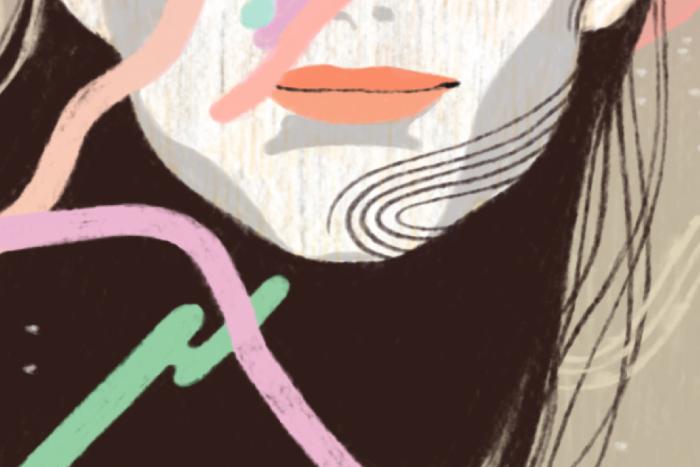1. In 1983, the New York band Liquid Liquid released Optimo, an EP whose four songs would ultimately make up a large fraction of their entire discography. This was dance music without outward joy, pushing the repetitive logic of funk into functionalism: “Tight grooves” as the constricted circuit of a mechanical chain. You hear little more than bass, drums and other percussion, unlike disco’s luscious orchestration, with snare rolls doubling back onto themselves. Vocals were sometimes gibberish, usually paranoid-sounding, countering the music instead of trying to meld with it. Already an acetate hit, the track “Cavern” became renowned far beyond underground clubs or local black radio when Sugar Hill Records plagiarized its two-note bass line for Melle Mel’s “White Lines.” After one label sued the other, Sugar Hill declared bankruptcy to avoid paying the huge legal fees, and that was the end of Liquid Liquid’s first life. At the time, few people probably noticed that their bassist Richard McGuire also drew Optimo’s cover, though they may have lingered on its coiled reddish-yellow whorls or the band name you could only read by moving the record around.
Liquid Liquid were a model for later dance-punk bands; you can sense their galvanizing tension in much of the DFA Records catalogue, and when LCD Soundsystem played farewell shows at Madison Square Garden several years ago, James Murphy invited them to open for him. But Richard McGuire had already become more influential in another tradition altogether. In 1989 he published the six-page comic “Here,” with its simple yet intricately variegated conceit: every panel depicts the same piece of New Jersey land, from a modern living room to the colonial era to the Jurassic one, as temporal holes erupt and multiply within each image. The cartoonist Chris Ware has described the effect of McGuire’s strip on him like a supernatural revelation. Last year he wrote: “It pictured the corner of a room from a fixed viewpoint, projecting a parade of moments, holidays, people, animals, biology, geology—everything, it seems, that defines and lends human life meaning—on to windows of space labelled by year (1971, 1957, 1999, 100,097 BC). Birthdays, deaths, dinosaurs. In 36 panels, the universe.”
“Here” was sort of a comics equivalent to a revered dance-punk single. It even had the polyrhythms. So when Pantheon published a book-length version of McGuire’s piece recently, I wasn’t sure how I felt about it. Why spend years of effort writing orchestral arrangements for a no-wave record? A comic of this kind had never been seen before, and the world adapted it to so many new purposes afterwards. To me, “Here” resembled “The Vane Sisters” or certain Missy Elliott singles, works reveling in the triumph of their existence. I didn’t realize that McGuire could recycle the original concept while unpicking all its seams—a determination signaled by omitting “Here” from Here.
2. And what was its own miniature context, this strip? “Here” initially ran in the second volume of Francoise Mouly and Art Spiegelman’s RAW magazine, which coupled modernist formal ingenuity with the pop élan native to comics. In his monograph about Mouly’s career, Jeet Heer argued that it emerged during a wasteland period for the medium, “the nadir.” He quotes the novelist Carter Scholz: “[RAW] may be the last thing standing between us and an eternity of The Incredible Hulk.” One of Mouly’s day jobs then was creating a map and guide to the not-yet-gentrified streets of Soho. Having landed in New York abruptly and alone some years earlier, did she find it thrilling when “Here” disoriented a familiar place? She and McGuire were both outsiders to comics culture in their own unlikely ways.
All that extra space affords him subtler mingling. Comic timing gets distended across 10,000 years. Pre-Columbian aboriginals seemingly speak to 1950s suburbanites. Word balloons straddle centuries, and an ancient tree looms over the present. McGuire likes to suggest parallel behaviour, as with the spread of various characters dancing or posing. Even if the East Coast is wetlands circa 2300, we’ll probably still be flirting.
As the art editor at The New Yorker, Mouly still publishes McGuire’s work. A cover he illustrated last November approaches the reflectiveness in the expanded Here, transposing a single New Yorker through remote decades of technology, transportation and fashion. It reminds me of the inspiration behind Luc Sante’s chronicle Low Life, whose author found that those old buildings hosting long-shuttered establishments like the Rat Pit or Suicide Hall often survived into pre-Giuliani Manhattan. (McGuire once roamed the city making street art, running into Keith Haring and Jean-Michel Basquiat.) And by elaborating on itself, the new Here also surveys the medium’s history in fragments of genres—this is momentarily a war comic and a biographical comic and a funny-animals comic and a science fiction comic, though always circling back to the domestic and the intimate.
3. “Life has a flair for rhyming events,” Ben Franklin says midway through Here. He comes to be hopelessly estranged from his son William, a loyalist and the last colonial governor, occupying a mansion near Richard McGuire’s childhood home in Perth Amboy, New Jersey. The Ben Franklin, not the one who’s already appeared at a 1990 Halloween party. The original “Here” played out like an audacious trick. Now and then McGuire draws similarly direct juxtapositions—an ominous coughing fit in one year coincides with a house fire in another—but all that extra space affords him subtler mingling. Comic timing gets distended across 10,000 years. Pre-Columbian aboriginals seemingly speak to 1950s suburbanites. Word balloons straddle centuries, and an ancient tree looms over the present. McGuire likes to suggest parallel behaviour, as with the spread of various characters dancing or posing. Even if the East Coast is wetlands circa 2300, we’ll probably still be flirting.
Shifting between larger movements and recurring leitmotifs, Here flows with the vast precision of symphonies. Each era receives its own colour, like an instrument’s tone. The 20th-century living room is bounded by digital pastels, while a toxic catastrophe in the distant future casts sickly green hazmat suits against a desaturated landscape. In 3 000 000 000 BCE, primordial hues lie nebulous on the page; dawn smudges the forest of 1203; and 20,000 years from now giant hummingbirds joust over a pale pink flower. McGuire has given the original short’s awkward, rudimentary figures understated new faces—each character lightly marked out in pencil, as if to prevent any particular one from growing too prominent or memorable. They could almost be paper dolls.
4. Earlier this week, McGuire went over the architecture of his comics at a University of Toronto discussion. The house in “Here” was originally supposed to be an “everyplace,” he explained, but revisiting the story made him want more specificity from it. (“When I first did the strip he was a cat in the future,” McGuire said about one cast member, “and now he’s a cat in the past.”) He marveled at a Japanese woman who described the new book in terms of “the sadness of things.” Many of his reference models came from the vernacular photography of Peter Cohen, pursuing people during unguarded moments. William Franklin’s real residence (known as Proprietary House) and its development from Georgian mansion to seedy hotel to reclaimed landmark don’t exactly mirror their fictional counterparts, but McGuire had something better than historical fact. He showed family photos of Revolutionary War re-enactors milling around the building in 1976: a Here panel staged as theatre.
Every image in the comic now roams across a double-page spread instead of the original’s breathless six-panel grid, allowing compositions and rhythmic variations that would’ve been impossible before. At the same time, the reader’s viewpoint is locked into a quasi-isometric perspective—Chris Ware giving ideas back to McGuire, perhaps—with a corner of the 20th-century living room for its lodestar. All the couples look rather chaste as a result, yet the activities we do see montaged throughout Here have such casual grace. “In eight million years,” a TV announces to several characters, “our sun will start to swell in size, becoming a red giant … engulfing the orbits of Mercury, Venus and our Earth.” One day this eventful little space will hold nothing at all, but think of the uncountable canvases due to burn.






